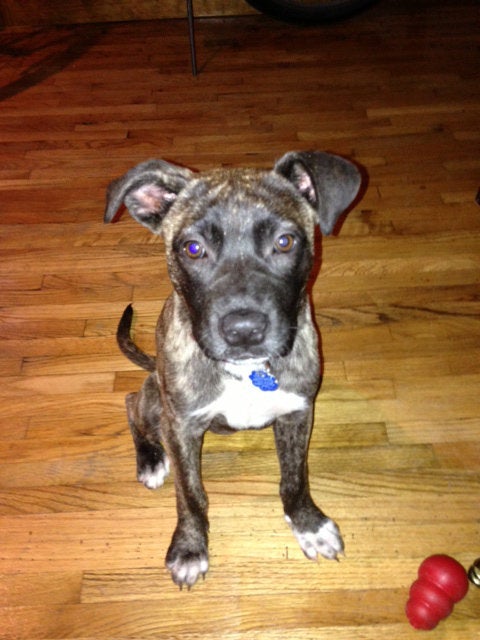
Whether or not you believe in unicorns, you can't deny the existence of one very common mythical creature living amongst humans today. This creature can often be found snoozing on couches, fetching balls in the backyard, or haphazardly bruising shins with a wildly wagging tail. This creature is known as the "pit bull."
You may think you have seen a "pit bull" before, or even scratched one of their wiggly booties, but in fact, the breed "pit bull" is a myth. There are at least seven breeds of dogs that are commonly lumped into the category of the pit bull-type dog: the Argentine Dogo, the Bull Terrier, the American Bulldog, the Presa Canario, the Boxer, the American Pit Bull Terrier and the American Staffordshire Terrier.
Here is a quick overview of each of these individual breeds:
•The Argentine Dogo is traditionally a South American big-game hunter. These dogs are large, strong and intelligent.
•Bull Terriers have oblong faces and are outgoing and sociable. They are a very active and trainable breed.
•The American Bulldog is a good-natured dog with a heavy build. They were originally used as working farm dogs, but now are very popular as family pets.
•Presa Canario is a mastiff breed from the Canary Islands. Used for driving cattle or hogs, these dogs are calm, attentive and obedient with family members.
•Boxers are sweet, happy and playful dogs that are very patient, especially with children.
•The American Pit Bull Terrier and the American Staffordshire Terrier at one time were considered the same breed, but now they have distinct bloodlines. They are both loyal and protective family companions.
The public identifies purebred dogs from any of these breeds as "pit bulls," when in fact, they are each very different animals with a unique appearance and personality. The definition used by the public, media and many shelter workers describe the pit bull as a "medium to large build with a muscular back end, wide head and short hair."
How many breeds could be described this way?
Labrador retrievers, Rottweilers, Catahoula Leopard Dogs, any type of Mastiff, numerous breeds of hound, Weimeraners, Dalmations and any combination of hundreds of types of dogs could produce offspring that meet this vague physical description.
The fact is that the vast majority of dogs identified as "pit bulls" are actually mixed breed dogs, and it's difficult to visually determine whether or not these dogs possess genes from the breeds listed above.
It's no secret that the term "pit bull" has become an incredibly controversial label, and there are many proposals around the world for breed specific legislation (BSL) against dogs given this label. This may have something to do with the history of 'pit bull' type breeds.
Traditionally, the American Pit Bull Terrier and the American Staffordshire Terrier (the two breeds most commonly labeled as "pit bulls") were favored for two very distinct purposes: dog fighting and companionship. Despite their historical and modern exploitation in dog fighting rings, they were dubbed "America's dog" in the 1900s because of their favorable temperament and incredible loyalty.
They were great with kids, and were also very useful for hunting. These terriers were even poster dogs for the military in World War I because of their protective nature and their athletic build. The breed "Staffordshire Terrier" was officially accepted for registration by the American Kennel Club in 1936.
Breed specific legislation is not an effective course of action against any type of dog, but especially so against pit bull-type dogs as there is no sound scientific process for determining what makes a dog a "pit bull." BSL requires visual breed identification, which is often done by animal control officers or veterinarians, neither of whom have the specific technical training required to perform this task.
A study published in the Journal of Applied Animal Welfare Science in July 2009 compared DNA-based breed identification results against shelter workers' visual breed labels. The DNA-based tests did not agree with shelter workers' opinions 87.5 percent of the time. Proving that visual assessment is an unreliable method of breed identification.
However, DNA-based tests aren't the answer either, because these are not yet accurate enough for widespread use. The commonly available doggie DNA tests look for traits of around 180-250 breeds, however, worldwide there are between 400-800 recognized breeds of dog. So while your dog may fit within a few of these breeds, this is not an exact science. For a pit-bull type dog, this could even be dangerous. His DNA may show minute traces of one of the seven 'pit bull' breeds, even if he is almost entirely another breed, but this DNA marker alone could be enough to cause him to unfairly be subjected to certain laws regarding a targeted breed.
Even if visual breed identification was possible, there is still a great deal of variation in temperament and behavior among dogs within each genetically distinct breed. Therefore, we can't make broad generalizations based on breed lineage.
Other myths associated with pit bull-type dogs? Locking jaws. Plain and simple -- this is untrue. The jaws of these dogs function the same as any other domestic canid. The average bite strength of the domestic dog as determined by National Geographic's Dr. Brady Barr is around 320 PSI (pounds per square inch). Dr. Barr tested pit bull type dogs against Rottweilers and German Shepherds, and the pit bull-type dogs tested had the lowest PSI of the three at 235 PSI. Human bite strength is approximately 120 PSI.
Another myth? Pit bulls don't feel pain. Again -- untrue. The nervous system of these dogs function the same as any other type of dog. Do they have a higher than average tolerance for pain? Perhaps. This is likely due to the "gameness" that many breeders of these types of dogs reference, meaning the willingness to continue their assigned task despite discomfort.
The worst one? Pit bulls are inherently dangerous. I call "false" on this one, as well. Take a look at The Majority Project if you'd like to see what life is truly like with a pit bull-type dog. These dogs are inherently trainable. Just like children, when they are well-loved, well-nourished, and well cared for - they flourish, and these dogs can be the most lovable and goofy of family pets. When they are treated terribly, trained to do terrible things, they do so to appease the humans they regard as their own. This is not the fault of the dog, this is the fault of the human.
What this all comes down to is that passing regulations against certain breeds simply because of unsavory incidents committed by a few animals isn't a fair or constructive way to protect people from attacks. We need to call off the witch hunt for the mythical "pit bull" and instead focus on providing the proper care and training for each and every dog, regardless of the breed or mix of breeds, in order to ensure that our family pets grow up to be as docile and lovable as we know they can be. And stop this bias that results in approximately 1.2 million pit bull-type dogs being euthanized in shelters across the country every year.
Let's let the myth of the "pit bull" go the way of the Unicorn... back to FantasyLand where it belongs.
For the second year, The Huffington Post is holding a week-long, community-driven effort to bust the myths and raise awareness about pit bulls, a maligned "breed" that often bears the brunt of dated, discriminatory legislation that can make it near impossible for these dogs to find a forever home. You can follow along with HuffPost Pit Bull Week here, or on social media where we'll be using the hashtag #PitBullWeek.
Also on HuffPost:

